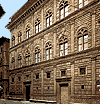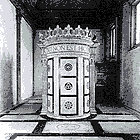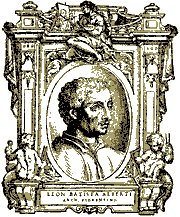Philosopher, architect, musician, painter and sculptor
Genova 1406-Rome 1472
He was one of the major figures of the Renaissance, an elaborator of mathematical
perspective and theoretician of art.
The son of an exiled Florentine, he studied in Padua and Bologna, arriving in
Rome as an "apostolic abbreviator" in 1432 and this was where his interest
in Classicism was first born: two years later he wrote "Descriptio Urbis
Romae", the first systematic study on the reconstruction of the Roman city.
Inspired by the art of antiquity, he elaborated the theory of beauty being harmony,
that it can be expressed mathematically in every way and that the "proportions"
of the Roman buildings contain the basis of architectural design.
This harmonic vision is to be found in all his work.

Palazzo Rucellai
in Via della Vigna
He arrived in Florence in 1434 and discovered the confirmation of his principles in the art of Brunelleschi, Masaccio and Donatello protègè of the Rucellai family, he created two of his most important works in Florence for them: (started in 1455 and today the seat of the Alinari Museum), whose facade is a pure geometric structure divided by pilaster strips and Doric, Ionic and Corinthian ornaments, and the elegant little Temple of Santo Sepolcro (1467) in the Rucellai Chapel near San Pancrazio (which today contains the Marino Marini Museum), built with the same proportions as the Holy Sepulchre in Jerusalem.In the same year Marquis Ludovico Gonzaga charged him to do the tribune of SS.Annunziata.

Chapel Rucellai
The Little Temple of the
Holy Sepulchre
He also completed the facade of Santa Maria Novella (1470) by lining the upper part and the main entrance with marble and, above all, by placing a classic triangular tympanum on top with two inlaid volute at the sides to hide the sloping roofs above the lateral aisles.

St. Maria Novella
Facade and Tympanum
However most of his architectural work was to develop elsewhere: in
Rome, as an archeologist-restorer for Santo Stefano Rotondo and Santa
Maria Maggiore; in Rimini, where he built the Temple Malatestiano
(1450), a real demonstration of Renaissance classicism which also respected
the design of the original Gothic church; and lastly in Mantua, where
he left the "summa" of his architectural ideas in the churches
of San Sebastiano (1460) and Sant'Andrea (1470), which were to anticipate
the typical designs for churches during the Counter-Reformation.
In the meantime he wrote the "De Pictura" (1436, dedicated to Brunelleschi),
the "De Re Aedificatoria" (1452) and the
"De Statua" (1464). If Brunelleschi was a builder, Alberti
was a theoretician: he gave a scientific basis to works of art and
ennobled the figure of the artist, placed painting, sculpture and
architecture on the same level as literature and philosophy. The
craftsman became an intellectual.

